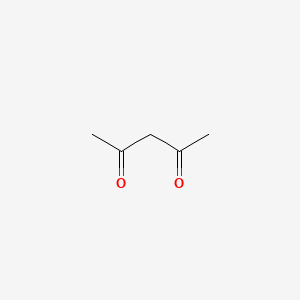| MeSH term | MeSH ID | Detail |
|---|---|---|
| Adenocarcinoma | D000230 | 166 associated lipids |
| Body Weight | D001835 | 333 associated lipids |
| Dermatitis, Contact | D003877 | 59 associated lipids |
| Eczema | D004485 | 4 associated lipids |
| Edema | D004487 | 152 associated lipids |
| Fetal Resorption | D005327 | 15 associated lipids |
| Glioma | D005910 | 112 associated lipids |
| Nervous System Diseases | D009422 | 37 associated lipids |
| Purpura, Thrombocytopenic | D011696 | 2 associated lipids |
| Seizures | D012640 | 87 associated lipids |
2,4-pentanedione
2,4-pentanedione is a lipid of Fatty Acyls (FA) class. The related lipids are Butyrates.
Cross Reference
Introduction
To understand associated biological information of 2,4-pentanedione, we collected biological information of abnormalities, associated pathways, cellular/molecular locations, biological functions, related genes/proteins, lipids and common seen animal/experimental models with organized paragraphs from literatures.
What diseases are associated with 2,4-pentanedione?
There are no associated biomedical information in the current reference collection.
Possible diseases from mapped MeSH terms on references
We collected disease MeSH terms mapped to the references associated with 2,4-pentanedione
PubChem Associated disorders and diseases
What pathways are associated with 2,4-pentanedione
There are no associated biomedical information in the current reference collection.
PubChem Biomolecular Interactions and Pathways
Link to PubChem Biomolecular Interactions and PathwaysWhat cellular locations are associated with 2,4-pentanedione?
There are no associated biomedical information in the current reference collection.
What functions are associated with 2,4-pentanedione?
There are no associated biomedical information in the current reference collection.
What lipids are associated with 2,4-pentanedione?
Related references are published most in these journals:
| Lipid concept | Cross reference | Weighted score | Related literatures |
|---|
What genes are associated with 2,4-pentanedione?
There are no associated biomedical information in the current reference collection.
What common seen animal models are associated with 2,4-pentanedione?
There are no associated biomedical information in the current reference collection.
NCBI Entrez Crosslinks
All references with 2,4-pentanedione
Download all related citations| Authors | Title | Published | Journal | PubMed Link |
|---|---|---|---|---|
| Endert G et al. | [Skin decontamination in the use of indium oxinate for cell labelling]. | 1983 | Radiobiol Radiother (Berl) | pmid:6407062 |
| Mathias CJ and Welch MJ | Radiolabeling of platelets. | 1984 | Semin Nucl Med | pmid:6427929 |
| Peters AM et al. | The interpretation of platelet kinetic studies for the identification of sites of abnormal platelet destruction. | 1984 | Br. J. Haematol. | pmid:6430336 |
| Patil VW | Chemical modification of lysine and tryptophan residues from glutamate dehydrogenase using 2,4-pentanedione and 2,3-dioxo-5-indoline sulphonic acid. | 1984 | Indian J. Biochem. Biophys. | pmid:6441772 |
| Watanabe M et al. | [Stable sulfur ylides. VL. The reaction of dimethylsulfonium acetylmethoxycarbonylmethylide and dimethylsulfonium diacetylmethylide with isoquinoline 2-oxide (author's transl)]. | 1978 | Yakugaku Zasshi | pmid:650394 |
| Pongsawasdi P and Anderson BM | Inactivation of rat ovarian 20 alpha-hydroxysteroid dehydrogenase by N-alkylmaleimides. | 1984 | Arch. Biochem. Biophys. | pmid:6593001 |
| Palaitis W and Curran JR | HPLC assay for guanidine salts based on pre-column derivatization with acetylacetone. | 1984 | J Chromatogr Sci | pmid:6707182 |
| Fregert S et al. | A simple method for the detection of formaldehyde. | 1984 | Contact Derm. | pmid:6713848 |
| Cole SC and Kuwahara SS | Acetylacetone method for glycine improved by use of ammonium citrate buffer. | 1984 | Clin. Chem. | pmid:6733911 |
| Smith FA et al. | PAC studies of 111In binding to transferrin, tropolone and acetylacetone in aqueous solutions. | 1984 | Int J Appl Radiat Isot | pmid:6735495 |
